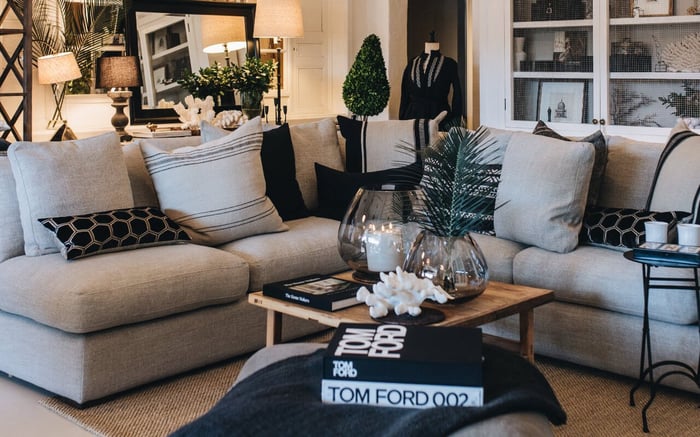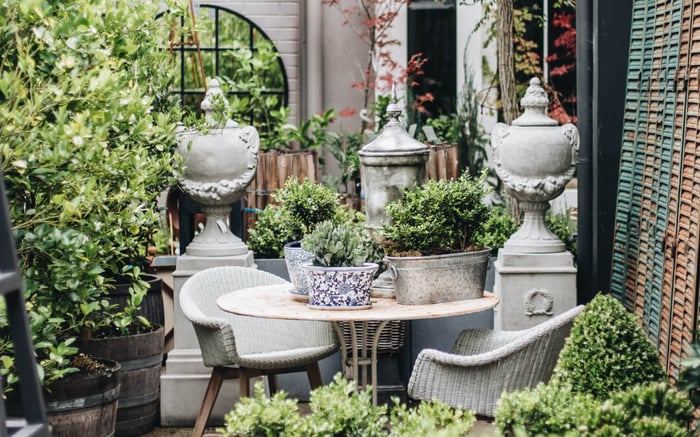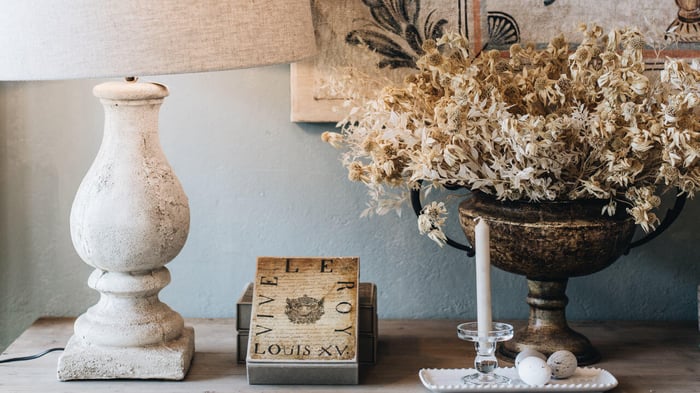Comfortable living involves designing spaces that are inviting, cosy, and relaxing.
When designing a home or interior space, it's important to take into consideration the multi-sensory nature of the human experience and to design spaces that support emotional well-being and relaxation.
Our sensory experiences are closely tied to our memories and associated emotions. Therefore, by designing our homes in ways that are pleasant and enjoyable to the senses, we can create positive emotional associations with those spaces and enhance our overall well-being.
To create a truly sensory home, it is important to consider all aspects of the home environment, from the layout and furnishings to lighting, textures, music, air quality, temperature, and more. By doing so, you can create an immersive sensory experience that is simultaneously visually pleasing, emotionally satisfying, supportive of our well-being, and most of all comfortable.
SHOP THE SENSORY COLLECTION
Here are some of our top tips to help you achieve a comfortable interior design:

Photo Source: Suzie Anderson Home
Comfortable Living Tip #1
Sight:
Sight is our primary sense when it comes to home design. From our choice of lighting to our colour palette, indoor greenery, decorative accessories, and more, these elements work in harmony to create a visually pleasing and comfortable home.
For example, you might use warm and muted earth tones in a living room to create a cosy and calming atmosphere, or richer, bolder colors to create energy and vibrancy.
We love decorating with neutrals as they flow from one colour into the next, creating a seamless transition between rooms and within an open-plan living space.
Lighting
The use of light, both natural and artificial is the major key to creating an atmosphere in a space. It influences how we feel both mentally and emotionally.
Lighting can both invigorate and calm and adds another dimension to a space, bringing your home to life.
From task lighting to romantic candlelight, your choice of lighting adds depth, contrast, highlights, and overall visual delight. As mentioned in our series on lighting, a layered and cohesive light scheme has a significant impact on the mood and comfort level of a space.
Photo Source: Suzie Anderson Home
As always, we recommend including a combination of ambient, accent, task, and mood lighting. Installing dimmer switches and lightbulbs with a soft, warm glow will enhance the ambience, allowing you to tailor your lighting to your mood, current task, and time of day.
For example, just like the beautiful warm glow of a bedside table lamp will aid in restfulness, installing a low-level bathroom night light, or motion-sensor LED will provide a more comfortable experience for those middle-of-the-night wake-ups.
Photo Source: Suzie Anderson Home
Cool vs natural vs warm light.
Cool light can create a more energetic mood. Cool blue and a brighter light are ideal upon rising, and during work hours as it is known to stimulate focus, productivity, and aid in visual clarity.
Natural light can make you feel more uplifted, upbeat and offers a feeling of spaciousness and calm.
Lastly, warmer light is more ambient, intimate, and personal. For example, lower overhead lighting and wall sconces in warmer temperatures offer a more inviting feel. Table and floor lamps, and perimeter lighting on a dimmer also offer a feeling of privacy and comfort.
Photo Source: Suzie Anderson Home
Something Loved
Next, personalize your space by decorating with something loved.
Unique pieces from your travels, flea-market finds, special heirloom collections, family photos, indoor plants, and naturally found objects are all examples of something loved. These items create a lived-in feel and serve as conversation starters for guests and family members.
Decorating with something loved can also mean surrounding yourself with items that make you feel your best, such as your most-loved flowers, greenery, textures, scents, or sounds.

Photo Source: Suzie Anderson Home
For example, rattan is one of my all-time favourite materials, due to its tactile texture, natural weave, and organic look! I make sure I have an element of rattan in each room of my home, to carry the grounded, relaxed, and timeless feel throughout my home.
Comfortable living also involves letting go of what no longer serves you and looking after the items that delight you. You could extend this further, to create smart storage solutions that remove decision fatigue and keep your pieces looking ordered and accessible.
Round Rattan Placemats | Antique

$46.00
Rattan Items Please be aware that rattan is a natural material, so each rattan product is unique. Natural variations are expected and normal, meaning that not all rattan items will have the same colour consistency. You may notice slight differences… read more
Lastly, bringing elements of nature indoors can significantly enhance your well-being. We recommend watching our video on living energy to learn more.

Photo Source: Suzie Anderson Home
Comfortable Living Tip #2
Touch:
Next, consider how your sense of touch influences your level of comfort, through the layering of tactile textures.
Tactile texture refers to the actual feel of the surface texture, such as soft, smooth, rough, sharp, plush, ridged, hard, or studded. For example, marble is often smooth to the touch, whereas natural timber may have a slightly rough feel due to its natural contours.

Photo Source: Jenni Kayne
Next, layering soft furnishings will assist in both physical and psychological feelings of comfort, and may evoke emotions through positive associations with past experiences or memories. This can be achieved through the layering of additional cushions, rugs, window treatments, and throws within your home.
For more ideas, we recommend watching our video on layering and how to create a laid-back interior to learn more.
Comfortable Living Tip #3
Sound:
Sound is another important aspect of home design. Depending on the noise levels of your space, there are ways to absorb sound to reduce outside noise levels, such as acoustic panels or sound-proofing materials, as well as soundscapes, speakers, and other sound-generating objects to introduce sound into your home.
Ideas include:
1. Acoustic panels: Acoustic panels can be used to absorb sound and reduce noise levels in a space. They come in a variety of shapes, sizes, and designs, and can be customised to fit the aesthetic of your space.
2. Speakers: You can integrate speakers into your space to create a surround sound experience. Consider placing speakers strategically in different areas of the room to create an immersive sound experience. Music can evoke memories and emotions and can be used to create a specific atmosphere or mood in a space. Binaural beats, on the other hand, can influence brainwave activity and promote relaxation, focus, and meditation.

Photo Source: Architectural Digest
3. Soundscapes: Incorporating soundscapes into your design can create a specific mood or atmosphere in your space. For example, the gentle sound of flowing water, the crackling of an open fire, or the sounds of bird song, can create a calming and serene atmosphere.
4. Soundproofing materials: Soundproofing materials can also be used to block or reduce noise levels in a space. This is especially useful in spaces such as bedrooms, offices, or home recording studios.
5. Sound-generating objects: Objects and technologies such as wind chimes, a coffee machine, or musical instruments such as gongs, or sound bowls can add an interesting, engaging, and unique element to your space.

Photo Source: Suzie Anderson Home
Comfortable Living Tip #4
Smell:
Next, consider your sense of smell. This might involve using scented candles, oil burners, or diffusers to create a pleasant aroma, lighting incense, or incorporating lightly fragranced plants or flowers into your home.
Some scents that are closely associated with feelings of comfort include:
-
Vanilla: Vanilla has a warm, sweet, and comforting aroma that can evoke feelings of relaxation and happiness.
-
Lavender: Lavender has a calming and soothing scent that can help reduce stress and anxiety. Its aroma is often used in aromatherapy and relaxation techniques.
-
Cinnamon: Cinnamon has a warm and inviting scent that can be associated with home cooking and baking.
-
Freshly brewed coffee: Its aroma is often associated with mornings and starting the day off on the right foot.
-
Roses: Roses have a sweet and romantic scent that can evoke feelings of comfort and relaxation.
-
Baked Goods: Baked goods such as fresh bread, or the sweet aroma of homemade pastries, cookies, or cakes, can offer a sense of comfort, welcome, and nostalgia.
Ultimately, the scents you associate with comfort will depend on your individual experiences and memories.

Photo Source: Trudon
Comfortable Living Tip #5
Taste:
Lastly, taste can also be a part of sensory home design, particularly in the kitchen or dining areas.
Consider how your kitchen design and food presentation can engage your sense of taste. This might involve using high-quality ingredients, the gentle simmering of slow-cooked dishes, and even being mindful of how your choice of tableware, glassware, and cutlery can influence your sense of taste, and subjective ratings of how enjoyable certain foods are.
If you are interested in learning more about this, we recommend this article here.

Photo Source: Suzie Anderson Home
Some tastes that are often associated with comfort include:
-
Sweet flavours.
-
Salty flavours.
-
Savoury dishes with umami flavours.
-
Warm and hearty foods such as soup, curries, and other slow-cooked dishes are often associated with comfort.
-
Childhood favorites: Certain foods enjoyed during childhood can be comforting to us as adults, as they can evoke memories of comfort.

Photo Source: Jenni Kayne
Final thoughts...
Remember, comfortable living is more than just how you choose to decorate your space, it is about how you interact with your space, creating time for those small moments of joy that cultivate that restorative feeling of home.
Whether this is savouring the first sip of your morning coffee, taking time to care for your plants, finding a special corner for meditation or a gratitude practice, a family games night, and more - it is about cultivating daily practices that evoke feelings of connection and comfort.
By incorporating these elements into your interior design, you can create a comfortable and inviting space that you'll enjoy spending time in. Remember that the key to a comfortable interior design is to create a space that feels welcoming and personalized to your preferences.










